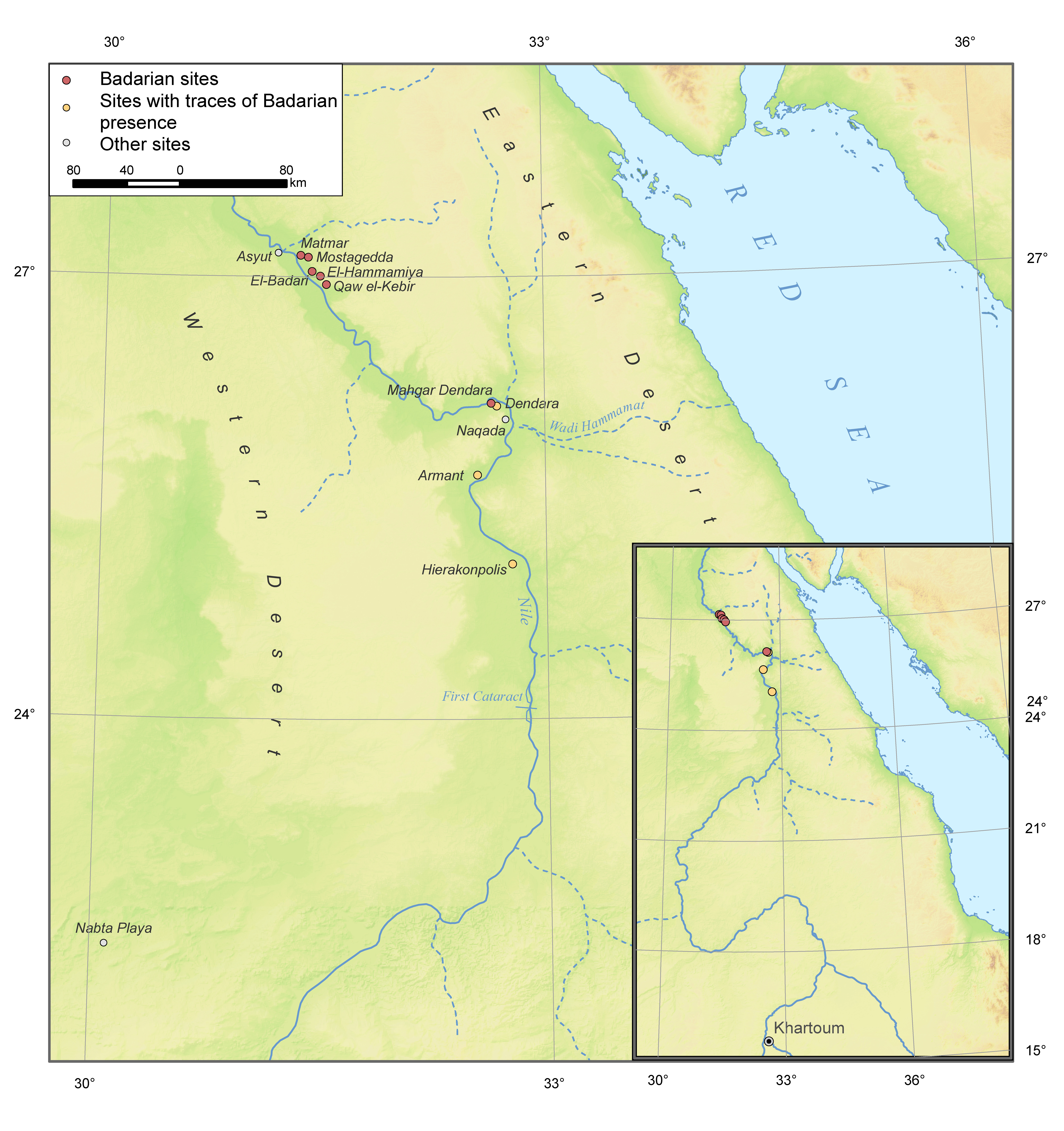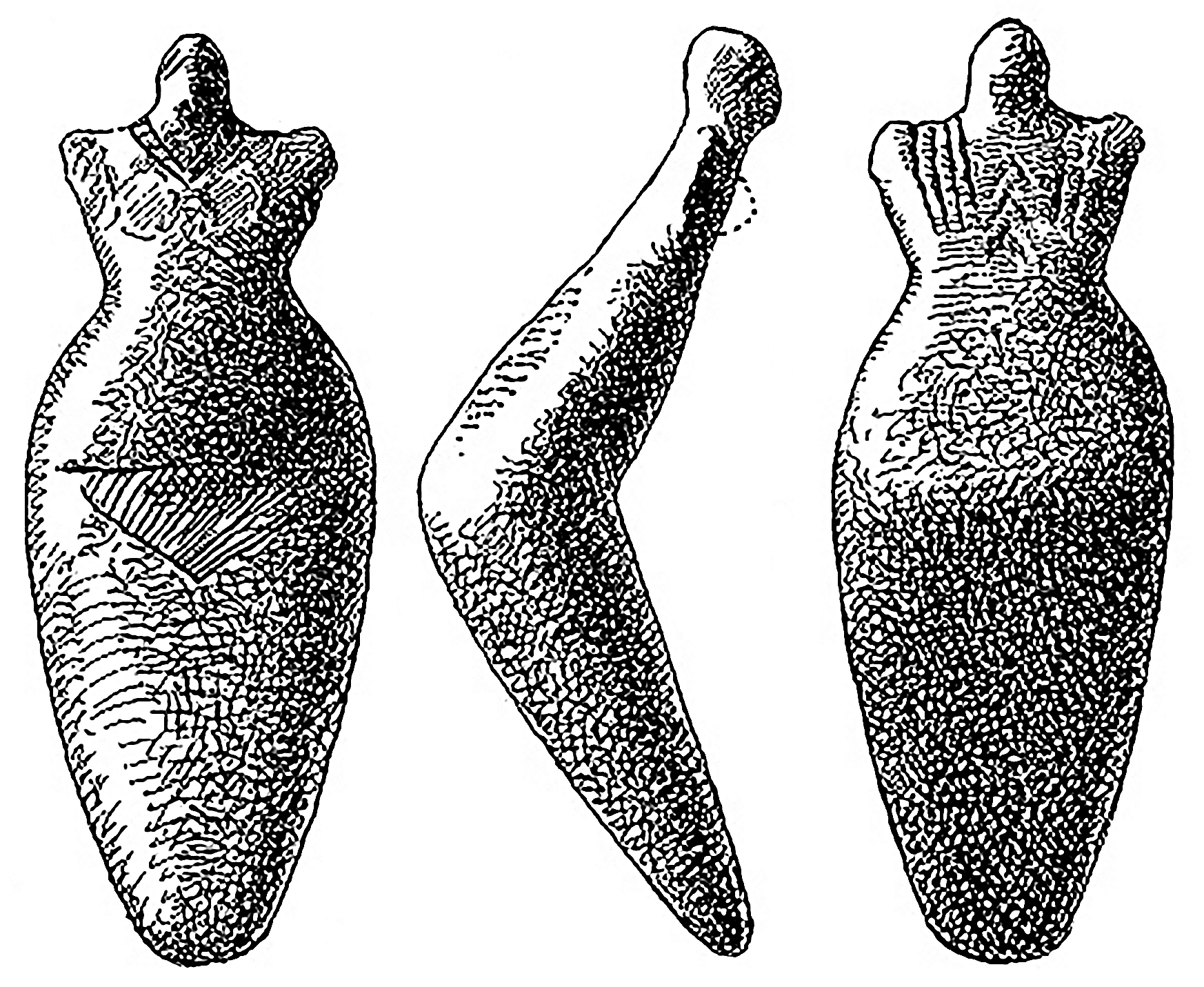Badari
- Region:
- Northeastern Africa
- Timespan:
- c. 4500–3800/3700 BC
BADARI — an Early Neolithic culture in Egypt (c. 4400–4000 or 4500–3800/3700 BC) that began the Predynastic Period of Egyptian history. Badarian culture is one of the earliest instances of agriculture on the banks of the Nile River.

Fig. 1. Map of the Distribution of Badarian Archaeological Sites
.jpg)
Fig. 2а. Badarian Culture. Female Ivory Figurine. In: Brunton, G., and G. Caton-Thompson. The Badarian Civilisation and Predynastic Remains near Badari. London: British School of Archaeology in Egypt: Quaritch, 1928. Publications — British School of Archaeology in Egypt and Egyptian Research Account, vol. 46. Pl. XXIV, 2
.jpg)
Fig. 2b. Badarian Culture. Female Clay Figurine. In: Brunton, G., and G. Caton-Thompson. The Badarian Civilisation and Predynastic Remains near Badari. London: British School of Archaeology in Egypt: Quaritch, 1928. Publications — British School of Archaeology in Egypt and Egyptian Research Account, vol. 46. Pl. XXIV, 1

Fig. 2c.Badarian Culture. Female Clay Figurine. In: Brunton, G., and G. Caton-Thompson. The Badarian Civilisation and Predynastic Remains near Badari. London: British School of Archaeology in Egypt: Quaritch, 1928. Publications — British School of Archaeology in Egypt and Egyptian Research Account, vol. 46. Pl. XXIV, 3

Fig. 3. Badarian Culture. Ivory Spoons. In: Brunton, G., and G. Caton-Thompson. The Badarian Civilisation and Predynastic Remains near Badari. London: British School of Archaeology in Egypt: Quaritch, 1928. Publications — British School of Archaeology in Egypt and Egyptian Research Account, vol. 46. Pl. XXII
BADARI (Badarian culture) — An Early Neolithic culture in Egypt (c. 4400–4000 or 4500–3800/3700 BC) that began the Predynastic Period of Egyptian history. The Badarian culture is one of the earliest instances of agriculture on the banks of the Nile River. The culture takes its name from the city of El-Badari along the east bank of the Nile in Middle Egypt in the Asyut Governorate (Fig. 1).
Relative Chronology and Location
The Badarian culture followed the Tasian culture, which many specialists consider an early phase of the former. It was succeeded by the Naqada culture (Amratian), with which Badari may have been contemporary in its terminal period. The main sites (groups of settlements and cemeteries) — Matmar, Mostagedda, Badari, El-Hammamiya, Qaw el-Kebir — are located on a stretch of land around 35 km southeast of Asyut at the edge of the desert. Traces of Badarian presence (artifacts, encampments and, possibly, one gravesite) were discovered in Mahgar Dendara, Wadi Hammamat, Armant, and Hierakonpolis in Upper Egypt.
Discovery and Research
The Badarian culture was discovered, studied and brought into scientific discourse by the British archaeologists Guy Brunton and Gertrude Caton-Thompson, who excavated its sites between 1922 and 1931 [Brunton 1927–1930; 1937; 1948; Brunton, Caton-Thompson 1928]. A new field investigation (of more than 30 Predynastic sites) and test excavations at the El-Hammamiya settlement (the key to studying the Badarian culture and Egyptian Predynastic Period in general thanks to its clear stratigraphy) was carried out by the British archaeologist Diane L. Holmes and American archaeologist Renée Friedman in 1989 [Holmes 1989; 1996; Friedman 1999; Holmes, Friedman 1994]. The origin of the Badarian culture has not been definitively established. One hypothesis posits a migration to the Nile from the Nabta Playa area in the Western Desert in the southern part of Egypt, 100 km from Abu Simbel, due to the climate of Northern Africa becoming increasingly arid [Wendorf, Schild 1994]. According to some researchers there may also be a connection with the Neolithic Khartoum culture in Sudan [Arkell 1947].
Settlements, Dwellings, and Burial Grounds
Settlements were located near the desert (savannah at that time) bordering the Nile Valley. Constructions were round and tended to be 1.0–2.3 m in diameter, and were presumably built so as to shield from the wind or were wattle and daub huts lined with matting or animal skins featuring hearths. Large bell-shaped pits (likely for household purposes), 0.7–1.7 m across and 1.0–4.5 m deep, and pottery vessels buried in the ground for storing supplies have been found.
Adjacent to the settlements were graveyards (usually on the eastern side). Altogether around 40 inhabited areas and 600 graves have been excavated. The dead were typically buried in oval (occasionally square) pits lined with reed mats. Corpses were generally laid in a contracted position on their left side with heads facing south, and were initially dressed in linen loincloths, sometimes with a head pillow made of straw or animal skins. In some instances, the corpses were wrapped in matting or skins. Some bodies were placed in what look like coffins made of sticks or reed.
The accompanying inventory included vessels made of clay and ostrich eggs, bone tools, ivory amulets in the shape of a hippopotamus, and, possibly, the head of a gazelle, jewellery (bracelets and necklaces) and items of personal hygiene (combs and cosmetic palettes). Several copper beads and one copper pin have also been found, as well as clay boat models and the fragment of a nose of a wooden boat model. Three graves contained three female figurines, two made of clay and one of ivory (Fig. 2). The heads of bulls or cows, sheep, antelopes, cats, dogs, and jackals were also frequently placed next to the bodies. There are also separate graves containing some of these animals (likely domesticated) wrapped in skins or covered in matting. Many Badarian graves were plundered in ancient times (according to Brunton, some of them appeared to be a burial ground of ‘high-status’ people, such as that indexed as Cemetery 5100 [Brunton, Caton-Thompson 1928: 6]).
Tools and Other Small Finds
The Badarian culture is the first in Egypt known to have manufactured objects of metal — a copper pin or even a needle of around 7.6 cm in length produced by cold forging [Brunton, Caton-Thompson 1928: 33, pl. XXVI, 5112]. Stone tools, such as flakes and blades, both notched and denticulated, were used. The finds include stone hand axes, bifacial knives, scrapers, side-scrapers, chisels, borers, sickle blades, arrowheads, grinding stones, as well as square and occasionally oval palettes with traces of ground ochre and malachite. Needles, pins and awls were made of bone. Carved spoons (Fig. 3) and ladles, small vessels, bracelets, beads, rings made of ivory, stone beads (carnelian, jasper, alabaster, etc.), and shells of Red Sea molluscs were also found.
Pottery
The pottery that distinguishes the Badarian culture is brown and red, thin-walled, polished, with a rippled surface (likely treated with a bone comb before firing) and a black top. Finds include straight-sided, conical, dome-shaped, and oval pots and bowls with rounded or flat bases, plates, bottle-shaped and double vessels, caliciform beakers with rounded bases, and incised geometric (straight lines, triangles) ornamentation.
Economy
The Badarians were primarily hunters and fishermen, with rudimentary cattle-breeding. Individual grains and small amounts of cereals have been found in Badarian storage pits, kitchen vessels, and graves. These include common wheat or emmer and four-row barley, indicating transition towards agriculture in the Nile Valley. However, according to French archaeologist Beatrix Midant-Reynes, farming was not the main activity of the Badarians [Midant-Reynes 2000: 160]. Their agricultural activity may depend on the formation of topsoil in the floodplain of the Main Nile, which began in Upper Egypt no earlier than the 6th–5th millennium BC and reached a level of soil depth necessary and sufficient for the establishment of productive farming by the 5th millennium BC [Proussakov 2009: 99].
Bibliography
Arkell 1947 — Аrkell, A. J. “Early Khartoum.” Antiquity, no. 21, 1947, pp. 172–181. Brunton 1927–1930 — Brunton, G. Qau and Badari. London: British School of Archaeology in Egypt; Quaritch, 1927–1930. 3 vols. Publications — British School of Archaeology in Egypt and Egyptian Research Account, vols. 44, 45, 50. Brunton 1937 — Brunton, G. Mostagedda and the Tasian Culture: British Museum Expedition to Middle Egypt: First and Second Years, 1928, 1929 / with a chapter by G. M. Morant. London: Quaritch, 1937. Brunton 1948 — Brunton, G. Matmar: British Museum Expedition to Middle Egypt, 1929–1931. London: Quaritch, 1948. Brunton, Caton-Thompson 1928 — Brunton, G., and G. Caton-Thompson. The Badarian Civilisation and Predynastic Remains near Badari. London: British School of Archaeology in Egypt: Quaritch, 1928. Publications — British School of Archaeology in Egypt and Egyptian Research Account, vol. 46. Friedman 1999 — Friedman, R. F. “Badari Grave Group 569.” Studies in Egyptian Antiquities: A Tribute to T. G. H. James / edited by W. V. Davies, London: British Museum, 1999, pp. 1–12. Publications — Occasional Paper, vol. 123. Holmes 1989 — Holmes, D. L. The Predynastic Lithic Industries of Upper Egypt: A Comparative Study of the Lithic Traditions of Badari, Nagada and Hierakonpolis. Oxford: British Archaeological Reports, 1989. 2 vols. Publications — BAR International Series, vol. 469; Cambridge Monographs in African Archaeology, vol. 33. Holmes 1996 — Holmes, D. L. “Recent Investigations in Badarian Region (Middle Egypt).” Interregional Contacts in the Later Prehistory of Northeastern Africa / edited by L. Krzyżaniak, K. Kroeper, and M. Kobusiewicz, Poznań: Poznań Archaeological Museum, 1996, pp. 181–191. Publications — Studies in African Archaeology, vol. 5. Holmes, Friedman 1994 — Holmes, D. L., and R. F. Friedman. “Survey and Test Excavations in the Badari Region, Egypt.” Proceedings of the Prehistoric Society, vol. 60, no. 1, 1994, pp. 105–142. Midant-Reynes 2000 — Midant-Reynes, B. The Prehistory of Egypt: From the First Egyptians to the First Pharaohs / transl. by I. Shaw; preface by J. Leclant. Oxford; Malden: Blackwell, 2000. Proussakov 2009 — Proussakov, D. B. Drevniĭ Egipet: pochva tsivilizatsii (ėtiud o neoliticheskoi revoliutsii) [Ancient Egypt: Soil of the Civillisation (an Essay on the Neolithic Revolution]. Moscow: Librokom, 2009 (in Russian). Wendorf, Schild 1994 — Wendorf, F. A., and R. Schild. “Are the Early Holocene Cattle in the Eastern Sahara Domestic or Wild?” Evolutionary Anthropology, vol. 3, no. 4, 1994, pp. 118–128.


